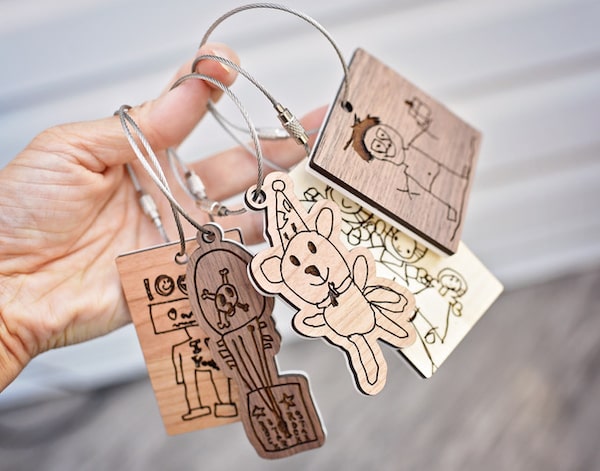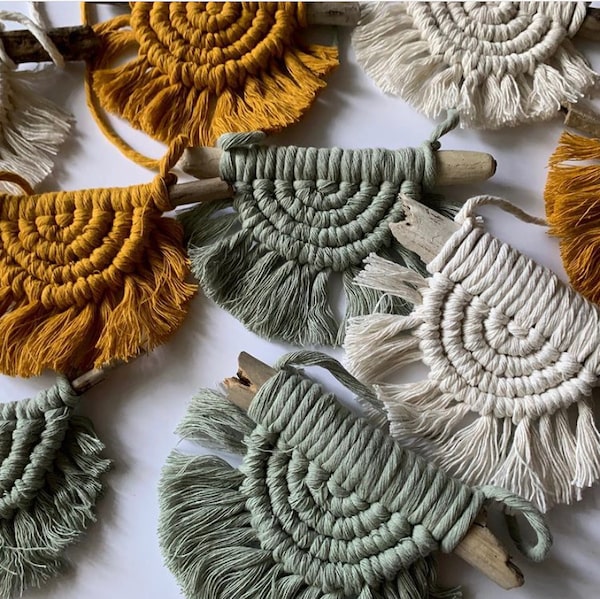
Thienly Azim started making crafts in quarantine, and has since turned it into a thriving side business.Thienly Azim/Supplied
When Riley Knudsen was laid off from her job as a restaurant manager in Vancouver in the early days of the pandemic, she filled her spare time with her hobby in the fibre arts.
Ms. Knudsen had been perfecting her macrame knotting skills for a few years. But it wasn’t until the pandemic began that she was motivated to turn her hobby into a business. “I just felt like I never really had the time or the expertise to create a legitimate business,” she explains. “But when the pandemic started, I lost my job like a lot of other Canadians, and then I had so much time on my hands. I thought, ‘Why don’t I just give this a try and just see how it goes?’”
In May, Ms. Knudsen launched her Etsy shop, BeachMacrameCo, and had her first sale two days later: a blue and white macrame wall hanging that she sold for $79.99. She grew her business by researching successful Etsy shops and learning how to market her business through platforms such as Instagram, using popular hashtags including #fiberartfamily and #inspiredmacrame. Ms. Knudsen now makes 10 to 15 sales a week.
Micro-ecommerce operations have flourished during the pandemic with an increase in first-time sellers. Etsy Canada reported a 252-per-cent year-over-year increase in new shop openings from July 1, 2020, to September 30, 2020, compared with the same period the year prior.

In May 2020, Ms. Knudsen launched her Etsy shop, BeachMacrameCo, and had her first sale two days later: a blue and white macrame wall hanging that she sold for $79.99.Riley Knudsen/Supplied
And a survey conducted in January 2021 by Angus Reid for the car-sharing company Turo reported that 34 per cent of respondents have taken on a “side hustle” since the pandemic started or plan to do so in the coming year. Forty-three per cent of respondents that have started or plan to start a side hustle have an income of less than $50,000, while 42 per cent have an income of $50,000 to $100,000. Twenty-eight per cent say they started their new business because they had more spare time on their hands. These numbers suggest that people who are starting side businesses aren’t doing so just for the money.
“This spare time does not necessarily mean work hours have been cut,” says Dr. Seung Hwan Mark Lee, an associate professor of retail management and marketing at Ryerson’s Ted Rogers School of Management. Instead, he attributes it to cancelled vacations and limited entertainment opportunities. “So now, people are utilizing [spare time] to set up their own businesses.”
For Calgary stay-at-home-mom Thienly Azim, cancelled vacations left her with a surplus of cash to spend on her crafting hobby. She purchased a laser engraver and cutter for $7,600 in May 2020. While she started off making crafts for her four kids and to give as gifts, she opened an Etsy shop to see whether she could pay off the cost of the machine. She did so after four months. Azim’s shop grew so busy that she says she was able to cover the cost of “groceries and more” for her family of five with her earnings between mid-November and mid-January.
The increase in popularity of supporting small, local businesses has also given micro-ecommerce a boost. These days, there’s more appeal in purchasing a homemade scrunchie than buying it online from Amazon – and people are willing to pay more for it. “We invest in the businesses that are important to us,” says Marie Josée Lamothe, academic director of McGill’s Dobson Centre for Entrepreneurship. On TikTok, the hashtag #SmallBiz generated 40.5 million video views in January.
Ms. Lamothe says that small-scale creators are taking advantage of social media platforms to not only market their products but to gauge interest. “I can develop one prototype of a T-shirt, take a beautiful picture, post it and take orders ahead of time. And once I have orders, I’ll go and produce them and tell my customers they’ll get them in three months. This is completely flipping around the business model where you produce, make it visible, then hope that people will come and buy it.” Pre-order business models decrease the financial risk for new business owners, making it easier for hobbyists to get involved.
Despite the growth in micro-ecommerce operations, only one per cent of side-hustle starters say they plan to quit their full-time job to pursue their new business venture full-time, according to the Angus Reid survey for Turo. Dr. Lee says the uncertainty of starting a small business makes it unrealistic for most to go all-in. “People who are unemployed are still going to look for stability,” Dr. Lee explains. “Setting up your own shop still requires capital, a lot of labour and time.”
Such was the case for Ms. Knudsen, who continued to search for full-time work. By August, she secured a position as a service manager at a different restaurant, working five days a week. But she still spends 12 to 20 hours over her two days off creating coasters, wall hangings, jewellery and car charms for her business.
Since she enjoys macrame so much, she doesn’t mind completing projects in her spare time. “I really like doing it,” she says. “So it doesn’t really feel like work.”

Thienly Azim/Supplied
Stay ahead in your career. We have a weekly Careers newsletter to give you guidance and tips on career management, leadership, business education and more. Sign up today.